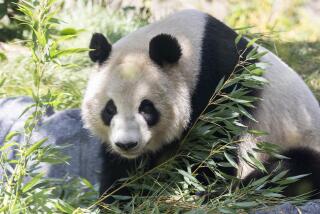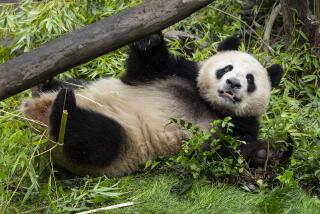Saving the giant panda
A foolish housekeeping mistake ended up costing the life of a beloved giant panda at the Jinan Zoo in China last week. Zoo staff were disinfecting an area that shared a ventilation system with the enclosure for Quan Quan, a 21-year-old panda that had given birth to seven cubs, earning her the title of âheroic mother.â Toxic fumes from the cleaning job caused her lungs to collapse.
Tragic accidents can befall animals in any setting â at a zoo, in a forest. But there is a special responsibility due to animals when humans hold them in captivity. (Quan Quan was born in the wild.) This most recent panda death serves as a reminder that the highly endangered animalâs best chance of long-term survival comes not from zoos but from extensive environmental stewardship.
China has done an admirable job on that in recent years. It has created 40 large preserves for pandas and heightened its patrols of those areas to protect the animals against poachers. In the late 1990s, it prohibited logging in the pandasâ habitat. The number of pandas in the wild appears to have risen from a low of about 1,000 in 1990 to more than 2,000, according to the World Wildlife Fund, though some of that might be the result of better counting.
At the same time that Quan Quan was poisoned, the Wolong Panda Protection and Research Center in Sichuan province was releasing four pregnant pandas into a tightly controlled woodland area, in the hopes that their offspring will have a ânaturalâ upbringing and learn to fend for themselves in the wild. The pandas will be closely monitored by surveillance cameras; the staff might artificially introduce the sights and smells of predators.
If it works, this would be the first successful reintroduction of pandas to the wild; a previous attempt ended in the pandaâs death. A more effective strategy entails preserving interconnected stretches of natural habitat for giant pandas. Environmental advocates are lobbying for wildlife corridors to connect the many panda preserves; so far, China is responding too slowly. Combating global warming could also prove crucial to saving pandas, which live within a particular environmental niche and eat bamboo almost exclusively. Scientists worry that with climate change, bamboo will die off in some areas and sprout up in others where preserves are impractical.
Zoos seemed the only hope during the 1990s, when the panda population was declining precipitously in the wild, tipped by habitat destruction and poaching as well as by nature. A mass flowering of bamboo led to the subsequent die-off of the plants, the pandasâ chief food source. But now scientists know more about pandas and what they need. As with so many other forms of wildlife, saving them is inextricably tied to preserving the natural world that we humans were too slow to fully appreciate.
More to Read
Sign up for Essential California
The most important California stories and recommendations in your inbox every morning.
You may occasionally receive promotional content from the Los Angeles Times.










